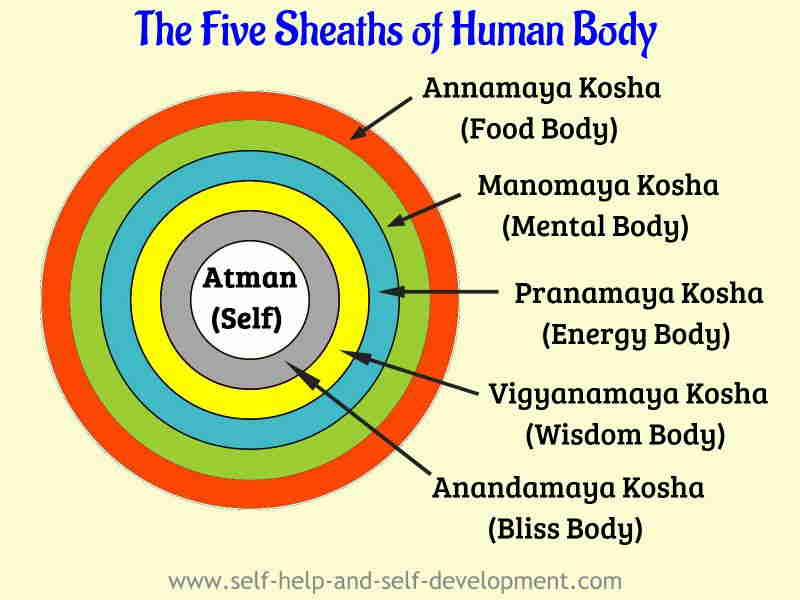The Five Sheaths Of Body
Let us get to know the five sheaths of body from a yogic point of view.
Yoga provides us with tools for achieving inner peace. And inner peace results in outward calm, happiness and joy. And when you have these qualities, life becomes a smooth journey instead of a rough ride.
According to our gross understanding of ourselves, and under the influence of modern medical knowledge, we know ourselves as our body and our mind. And the body is what is made up of the skeleton, muscles, blood, skin and so on.
But this is only the construction of the gross physical body. We also have subtler bodies, which we cannot see, just like the seven chakras.
Yogic science tells us that every human body is made up of five different sheaths or koshas in Sanskrit.
So let us try to understand these five sheaths of body or koshas in detail as it will help us know ourselves better. It will also give us knowledge of our whole self and help us in our inner exploration.
The Five Sheaths of Body or Koshas
According to the Taittiriya Upanishad, the five sheaths of body are:
1. Annamaya Kosha or Food Body
2. Manomaya Kosha or Mental Body
3. Pranamaya Kosha or Energy Body
4. Vigyanamaya Kosha or Etheric or Wisdom Body
5. Anandamaya Kosha or Bliss Body
The first sheath is known as annamaya kosha or the food body. This refers to our physical body. This body is the result of all the food that we have eaten. Hence the name. It is composed of the earth elements and returns to the earth after death. As a famous scientist once said, “Your body is food rearranged”.
The second sheath is the manomaya kosha or the mental body. We have to understand that mind and brain are separate things. The mind is not located only in the brain. Every single cell of our body has its own intelligence. Thus, the mind is everywhere, not just in the brain.
Today, there is talk of psychosomatic illnesses. This means what happens in the mind affects what happens in the body. Also conversely, what happens in the physical body affects the mental body.
Every fluctuation in the mental body generates a chemical reaction in the physical body and every chemical fluctuation in the physical body results in a fluctuation in the mental body.
The third sheath is the pranamaya kosha or the energy body. If the first sheath, the annamaya kosha is the hardware and the second sheath, the manomaya kosha is the software, then the third sheath, the pranamaya kosha is the energy that powers the first two.
These three bodies are all physical in nature. The second sheath is subtler than the first and the third is subtler than the second, but still, all three are physical in nature. A common example is a light bulb emitting light. The bulb is like the physical body or the annamaya kosha, the light it emits is the mental body or the manomaya kosha and the electricity that powers the bulb is like the energy body or the pranamaya kosha. The bulb, the light and the electricity all are physical in nature.
The fourth sheath is the vigyanamaya kosha or the etheric body. ‘Gyan’ means knowledge and ‘vigyan’ means vishesh gyan or special or extraordinary knowledge. Knowledge that we grasp through our five senses is ordinary knowledge. Knowledge that we grasp through sources beyond the five senses is extraordinary knowledge. Vigyanamaya kosha is the repository of such knowledge.
The first three sheaths are physical in nature while vigyanamaya kosha is transitory in nature. It is neither physical nor non-physical. It sort of connects the first three bodies and the fifth body.
The fifth sheath is the anandamaya kosha or the bliss body. This is a completely non-physical body. If one comes in contact with the bliss body, one experiences divine bliss. This non-physical dimension of ours can only be experienced. It cannot be ‘touched’ in the physical sense.
Yoga tells us that if the physical (annamaya), mental (manomaya) and the energy (pranamaya) bodies are perfectly aligned, then we can access the bliss body. For that to happen, work has to be done on the first three bodies.
It is hoped that this discussion of the five sheaths of body will kindle your curiosity to know more about Yoga and its benefits.
All Articles

New! Comments
Have your say about what you just read! Leave me a comment in the box below.